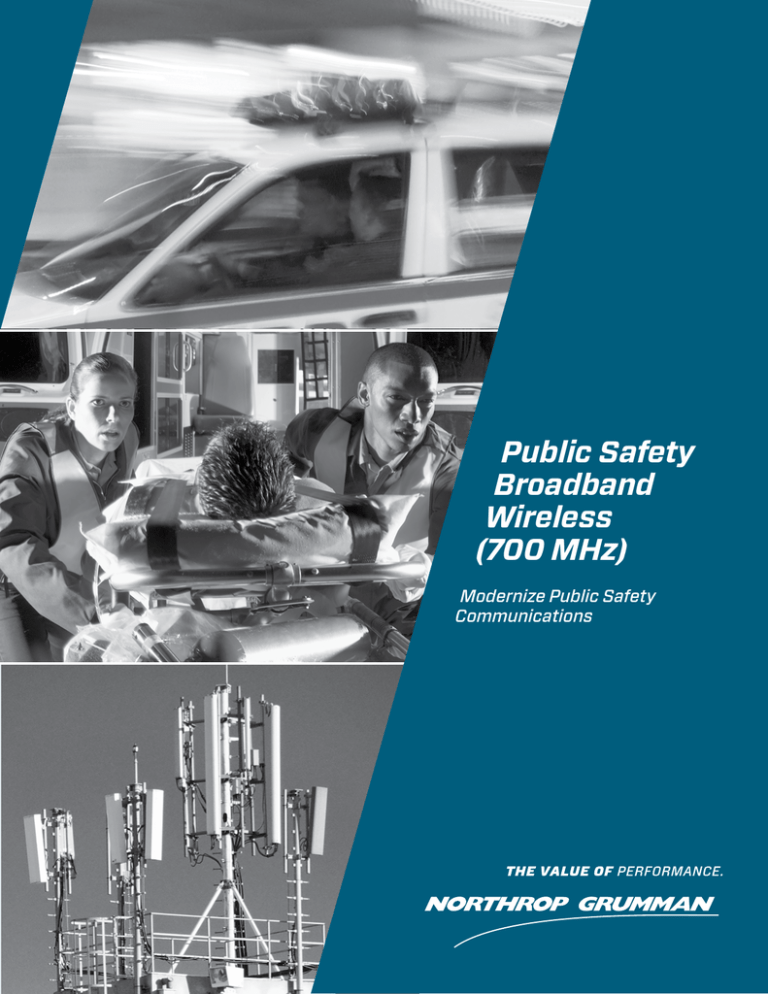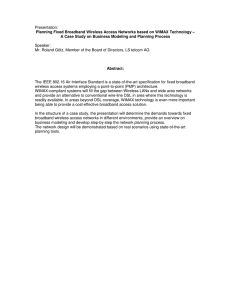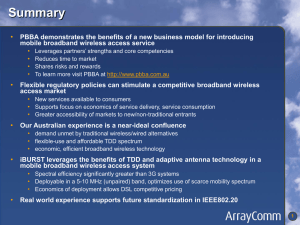
Public Safety
Broadband
Wireless
(700 MHz)
Modernize Public Safety
Communications
R
ecent emergencies and the
increase of complex threats
demonstrate the criticality
to provide accurate information to
first responders, in real-time, and
across jurisdictional boundaries.
The current public safety communication infrastructure is stove-piped
limited and outdated. Advances
in wireless technologies have the
potential to transform public
safety and operational execution.
Third generation (3G) and fourth
generation (4G) mobile broadband
wireless technologies, can significantly advance the operational
capabilities of public safety by
enabling a variety of missionenhancing applications including,
video streaming and surveillance,
location based services, and
license plate readers.
Public Safety Network
Characteristics
•
•
•
•
•
•
High Availability (99.999%)
Enhanced Security
Overlapping RF coverage
Site hardening
Backup power
Priority access/preemption
The Foundation for a
Broadband Wireless Future
For the last several years, the
public safety community has led
an effort to create a nationwide
public safety interoperable broadband wireless network that brings
enhanced data services and new
capabilities to first responders.
The Federal Communications
Commission (FCC) paved the way
for the realization of this network
by allocating a 10 MHz block of
spectrum in the 700 MHz frequency
band. There are legislative efforts
underway to allocate an additional
10 MHz of spectrum (D-block) to
ensure public safety’s broadband
data needs will be adequately met.
With the events that occurred
on September 11, 2001 there is a
sense of urgency among public
safety stakeholders to resolve
spectrum allocation and funding
issues so the long-awaited process
of creating a nationwide public
safety broadband network is able
to start in earnest. Public safety
leadership led by The Association
of Public-Safety Communication
Officials (APCO) and National
Public Safety Telecommunications
Council (NPSTC) are working
to develop a transparent and
accountable governance model
that provides local operational
control without impacting the
fundamental requirements of
nationwide seamless roaming,
interoperability, and security.
Critical Aspects of Public
Safety Network Design
& Operations
End–to-end security
• FIPS compliance
• Device and network security
• Access controls
• Application layer security
Application Integration
• Incident management tools
• Automatic Vehicle Location
• Video surveillance
• Biometry, telemetry & sensors
Testing and Validation
• System level testing
• Incident scenario testing
• Application performance
testing
• Security testing
Adapt Commercial
Technologies for
Public Safety Use
To leverage both the advances in
the commercial wireless technologies and market economies of scale
for devices and infrastructure,
public safety selected the Long
Term Evolution (LTE) technology.
LTE is currently being deployed
globally by commercial wireless
carriers, as a technology standard
for the public safety broadband
wireless network.
Although the commercial and
public safety broadband networks
will both use LTE technology, there
are key differences in design,
implementation, and management.
Public safety has unique and stringent requirements for network
availability, reliability, survivability,
and security due to the missioncritical nature of its operations
in contrast to commercial carrier
networks. First responders rely on
the high availability of their networks
in the execution of their mission,
especially in disaster situations
and situations that create a high
concentration of users.
Why a Systems Integrator?
• Proven processes for designing, implementing and testing
requirements that span multiple agencies and mission needs
• Single entity responsible for program implementation including
management of best-in-class technology suppliers
• Vendor neutral approach to applications and products selection
process, enabling needs-based technology upgrade
recommendations throughout the system lifecycle
• Integrating unique public safety requirements for security,
reliability and resiliency
• Customized integration of the network with agency back-end
enterprise systems without compromising operational efficiency
and security
State and local jurisdictions must
carefully consider critical aspects
of network design and operations,
as they develop requirements for
broadband wireless networks to
ensure their mission-needs are
fully met.
The vision of a mission-critical
public safety grade network that
meets the operational needs of its
users, requires proven systems
engineering processes of an
experienced systems integrator.
Northrop Grumman’s Role
to Fulfill Public Safety’s
Mission
Northrop Grumman is a trusted
partner for public safety providing
innovative solutions to state and
local organizations. Northrop
Grumman provides large-scale
Computer-Aided Dispatch (CAD)
systems to seven out of the ten
largest cities in the United States,
including New York, Los Angeles,
and Chicago.
Northrop Grumman was an early
visionary in recognizing the
importance of broadband wireless
technologies for public safety
communication capabilities. Our
extensive broadband wireless
research and engineering efforts
commenced more than seven
years ago to accomplish public
safety’s goal to deliver secure, highspeed mobile communications
to first responders as well as
secondary responders from other
state, local, and Federal agencies.
In 2006, Northrop Grumman led the
contract work for the Department
of Homeland Security (DHS)
SAFECOM program to develop
requirements for future
emergency communications.
Northrop Grumman’s extensive
experience as a systems integrator
derived from many years of
integrating diverse and complex
engineering and IT systems for
various government and public
safety enterprises. This helps
public safety agencies to mitigate
risk and achieve cost efficiencies
as it makes the leap to the next
generation of communications
systems and applications. It was
this experience, coupled with a
thorough understanding of public
safety mission needs, that enabled
Northrop Grumman to win the
highly competitive bid for designing
and deploying the nation’s first
public safety broadband wireless
network for the City of New York.
NYCWiN
Industry Collaboration
Northrop Grumman engineered,
designed and deployed a highly
reliable and secure 3G broadband
wireless network for the City of
New York, called NYCWiN. NYCWiN
expanded the City’s existing
infrastructure to provide a multiagency broadband communications capability that met the City’s
goals to mobilize its workforce,
deliver real-time information to
first responders, and enhance
situational awareness with realtime monitoring and management
capability. NYCWiN continues to
demonstrate its value to the
City’s public safety operations by
integrating customized mission
applications at more than 40 City
agencies serving secondary
responders with more agencies
added every day. Some of these
applications include: remote traffic
control, mobile inspections, sensor
management, wireless video,
license plate recognition, wireless
meter reading, emergency call
boxes, automatic vehicle location
(AVL).
Northrop Grumman actively works
with wireless industry leaders
and public safety stakeholders
to identify and bridge gaps
between commercial technologies
and public safety requirements
that could jeopardize the security
and reliability of the public safety
broadband wireless network. We
chair the network security and user
credentials working group of the
National Institute of Standards and
Technology (NIST) that defines
requirements for identity
management and certification and
accreditation of the public safety
broadband network for federal,
state and local use. We are also a
key contributor in the development
of 700 MHz Statement of
Requirements for the public safety
broadband wireless network and an
active participant in the NIST 700
MHz LTE Demonstration network.
NYCWIN is also helping the City find
innovative ways to lower operations
cost. The City is using NYCWiN to
control thousands of traffic light
signals eliminating leased lines,
recurring costs, and for reading
water meters eliminating manual
inspection costs. As the largest
operational broadband public
safety network in the United States,
the lessons learned from NYCWiN
provide significant value in reducing
risk and improving cost efficiencies
in the design and deployment of the
nationwide 700 MHz public safety
broadband wireless network.
www.is.northropgrumman.com/publicsafety
© 2012 Northrop Grumman Systems Corporation.
All rights reserved.
IS8201212ISD
Northrop Grumman has also
participated in the FCC’s 700 MHz
band proceedings and has
responded to various FCC Notices
of Proposed Rulemaking on issues
of interest to public safety.
For more information,
please contact:
Northrop Grumman
Information Systems
7575 Colshire Drive
McLean, VA 22102
703-556-1000
publicsafetysolutions@ngc.com
www.is.northropgrumman.com/
publicsafety




